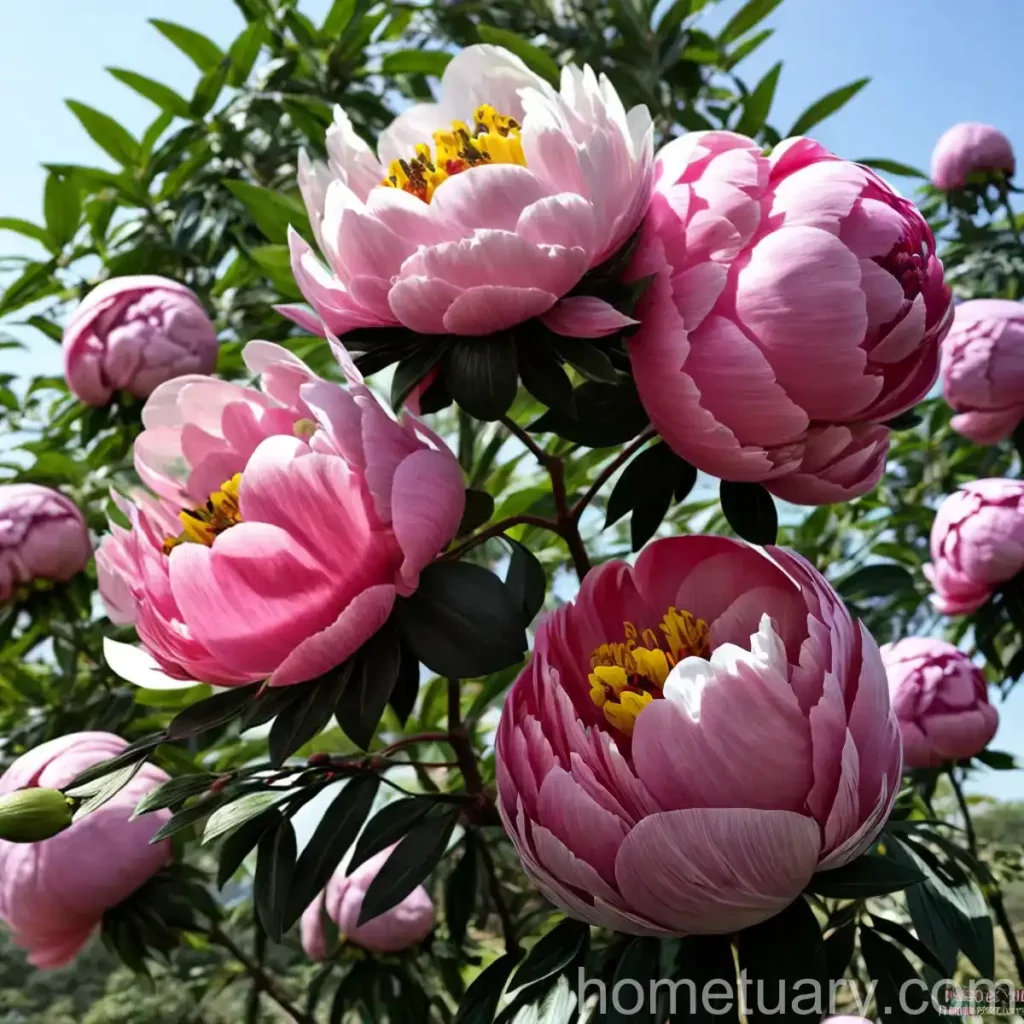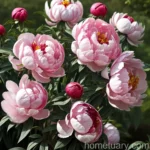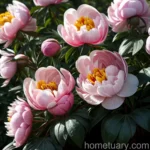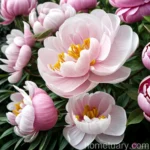Tree Peony (Paeonia suffruticosa ‘Hei Hua Kui’ CHAMPION OF BLACK FLOWERS)
Introduction
Tree peonies are one of the most exquisite and revered plants in the world of horticulture. Among the myriad of varieties, Paeonia suffruticosa ‘Hei Hua Kui’ stands out as the “Champion of Black Flowers,” boasting mesmerizing, deep black blooms. This article delves into the culture, uses, care, propagation, and interesting facts about this captivating plant.
What is a Plant: Tree Peony (Paeonia suffruticosa ‘Hei Hua Kui’ CHAMPION OF BLACK FLOWERS)
Tree peony (Paeonia suffruticosa) is a deciduous shrub native to China and is a member of the Paeoniaceae family. Known for its large, showy, and colorful flowers, it holds a significant position in Chinese culture and has been cultivated for over 1,500 years.
Tree peonies derive their name from the woody stems that they develop, in contrast to herbaceous peonies. Paeonia suffruticosa ‘Hei Hua Kui’ is a remarkable variety known for its striking black flowers, which distinguishes it from other peonies.
Key Takeaways – Tree Peony (Paeonia suffruticosa ‘Hei Hua Kui’ CHAMPION OF BLACK FLOWERS)
- Tree peonies are renowned for their large, showy, and long-lasting blooms.
- Paeonia suffruticosa ‘Hei Hua Kui’ is celebrated for its extraordinary black flowers.
- The cultural significance of tree peonies and their role in Chinese traditions is noteworthy.
- Effective care and maintenance are essential for healthy growth and abundant blooms.
- Propagation allows for the expansion of the tree peony population.
Culture
Uses
- Ornamental Purposes: Tree peonies, including Paeonia suffruticosa ‘Hei Hua Kui,’ are primarily cultivated for their ornamental value. They are often used in gardens, landscaping, and floral arrangements to add splendor and elegance.
Water
- Watering Frequency: During the growing season, tree peonies should be watered deeply once a week. Adjust the frequency based on the specific environmental conditions and soil moisture levels.
Sunlight
- Light Requirements: Tree peonies thrive in full sun to partial shade. They require at least 6 hours of direct sunlight per day to bloom vigorously.
Fertilizer
- Fertilization: Apply a balanced fertilizer in early spring just as the new growth emerges. Avoid over-fertilization, as it can lead to excessive foliage growth at the expense of flower production.
Soil
- Soil Type: Well-draining, fertile soil with a slightly acidic to neutral pH is ideal for tree peonies. Amending the soil with organic matter can improve its quality and texture.
Pruning
- Pruning Schedule: Prune tree peonies in late winter to early spring before new growth begins. Remove dead or damaged wood and ensure an open and airy growth habit.
Propagation
- Methods: Tree peonies can be propagated through division, root cuttings, or grafting. Each method requires specific techniques and timing for successful propagation.
Container Popularity
- Container Planting: Tree peonies, including Paeonia suffruticosa ‘Hei Hua Kui,’ are suitable for container planting, providing an opportunity to enjoy their stunning blooms on patios, balconies, or in small gardens.
Common Diseases
-
Botrytis Blight: Also known as gray mold, this fungal disease can affect tree peonies, causing dark brown spots on the leaves and flowers. Proper air circulation and reducing leaf moisture can help prevent its occurrence.
-
Phytophthora Blight: This soil-borne disease can lead to wilting, yellowing, and death of the plant. Ensure proper drainage and avoid overwatering to prevent phytophthora blight.
Disease Diagnosis
- Visual Symptoms: Diagnosis of tree peony diseases often involves observing visual symptoms such as leaf spots, wilting, discoloration, or abnormal growth patterns. Proper diagnosis is crucial for the effective treatment of the plant.
Common Pests
-
Aphids: These small, sap-sucking insects can infest tree peonies, causing distorted growth and the presence of sticky honeydew. Natural predators or insecticidal soap can help manage aphid infestations.
-
Spider Mites: Spider mites can cause stippling, discoloration, and webbing on the leaves of tree peonies. Regularly spraying the plants with water and using insecticidal soap can control spider mite populations.
Botanist’s Tips
-
Cultural Practices: Understanding the specific cultural requirements of Paeonia suffruticosa ‘Hei Hua Kui’ and implementing appropriate care practices are vital for its health and vigor.
-
Disease Prevention: Proactive measures such as maintaining proper air circulation, watering at the base of the plant, and vigilant monitoring can help prevent diseases and pest infestations.
Fun Facts
- The black flowers of Paeonia suffruticosa ‘Hei Hua Kui’ symbolize mystery, elegance, and the allure of the unknown.
- The cultivation of tree peonies holds profound cultural significance in Chinese history and traditions, often portraying wealth, honor, and appreciation.
Links to External Resources
Conclusion
Tree peony (Paeonia suffruticosa ‘Hei Hua Kui’ CHAMPION OF BLACK FLOWERS) exemplifies the splendor and diversity of the plant kingdom. From its culturally significant symbolism to its exceptional beauty and compelling care requirements, this remarkable plant continues to captivate and inspire enthusiasts and horticulturists worldwide.
Tree peonies, including Paeonia suffruticosa ‘Hei Hua Kui,’ invite us into a world of enchantment, mystery, and timeless elegance, reminding us of the profound connection between plants and human culture.
In cultivating and cherishing these extraordinary plants, we not only enrich our surroundings with their breathtaking blooms but also honor the enduring legacy of botanical artistry and excellence.
Keywords: Tree peony varieties, Paeonia suffruticosa ‘Hei Hua Kui’, Champion of Black Flowers, Peony blooms, Paeonia suffruticosa cultivars, Black-flowered peony, Tree peony species, ‘Hei Hua Kui’ peony, Black-blossomed peony, Paeonia suffruticosa characteristics, Tree peony hybrids, Peony flower color, ‘Hei Hua Kui’ tree peony, Black-flowered plant, Paeonia suffruticosa varieties, Tree peony symbolism, Black petal peony, ‘Hei Hua Kui’ characteristics, Dark bloom peony, Paeonia suffruticosa ‘Hei Hua Kui’ features, Tree peony cultivation, Black-flowered perennial, ‘Hei Hua Kui’ tree peony care, Peony flower meanings, Black beauty peony, Paeonia suffruticosa ‘Hei Hua Kui’ facts, Tree peony garden, Black flamed peony, ‘Hei Hua Kui’ peony variety, Paeonia suffruticosa ‘Hei Hua Kui’ growth, Tree peony landscape, Dark-colored peony, Black magic peony, ‘Hei Hua Kui’ tree peony pruning, Paeonia suffruticosa ‘Hei Hua Kui’ origin, Tree peony planting tips, Black flowering bush, ‘Hei Hua Kui’ peony fragrance, Paeonia suffruticosa ‘Hei Hua Kui’ care, Tree peony characteristics, Black blossom variety, ‘Hei Hua Kui’ tree peony diseases, Paeonia suffruticosa ‘Hei Hua Kui’ propagation, Tree peony in the garden, Black petal peony care, ‘Hei Hua Kui’ peony as a centerpiece, Paeonia suffruticosa ‘Hei Hua Kui’ pruning tips, Tree peony flower arrangements, Black blooming perennial, ‘Hei Hua Kui’ tree peony landscape design.















